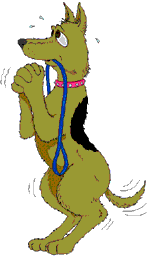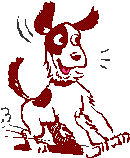Animal Training
"General Tips"
"General Tips"
Training Program
A training program involves short and long term goals for you and your dog. Short-term goals should start with the type of relationship you want to have with the dog. How are you going to build a relationship with your dog? How are you going to maintain the POSITIVE rapport you have established? What are the steps n training and maintaining behaviors? These are the questions you should ask yourself before attempting to train any behavior. By establishing short and long term goals, you are building a foundation of direction for you and your animal.
Punishment
Punishment should never be used as a result of a bad behavior or an undesirable behavior. The use of punishment will result in avoidance behavior where the animal will become afraid of you and will only do something out of fear of being punished. Escape behaviors and many other emotional responses associated with frustration, including aggression, may be associated with punishment. Being aggressive with your dog can make your dog aggressive with you, your children, the mailman, guests and even other dogs. Yanking your dog's leash when you want it to stop or come to you is a form of aggression that should be avoided at all costs. Not only is this cruel, but what purpose does this type of training serve? Yes it can immediately correct the problem but it is not a form of training. A slow POSITIVE and gentle process is the type of training you want to accomplish without aggressive behavior towards your animal.
Positive Attitude
Having a POSITIVE attitude is very essential in training your dog. What you give your dog is exactly what you will receive from him. If you are enthusiastic about working with your dog then you will receive the same response from him. After a training session with your dog, review your technique and progress. Then take any necessary steps towards improvement. This will benefit both you and your dog in helping to accomplish the desired goal.
Sessions
Training sessions and play sessions should be short, POSITIVE
sessions. Pushing your dog and constantly doing the same thing
over and over will create frustration and boredom. Vary your sessions
in length and reinforcement. Never try and cram everything into
one session. Short, quick and numerous sessions will accomplish
more than one long session. Constantly change and try to be one
step ahead of the animal. Once the animal starts anticipating
what you are going to do next, try something new before you lose
their interest. When training a new behavior do not constantly
do it over and over.  Intermittently
Change from something new to something that they are conditioned
to do. Never be predictable. A good trainer is never predictable
and is always stimulating and creative.
Intermittently
Change from something new to something that they are conditioned
to do. Never be predictable. A good trainer is never predictable
and is always stimulating and creative.
Philosophy
Most animals learn awfully fast if they are motivated. You
and your dog must have the right attitude. In order to teach
your dog to perform a trick, it's a good idea to choose a  trick that you at least think your dog might
enjoy doing. Start with something easy like "shake hands",
sit or stay. Use the reward technique. This will start the foundation
of rewarding your dog for good POSITIVE behavior.
trick that you at least think your dog might
enjoy doing. Start with something easy like "shake hands",
sit or stay. Use the reward technique. This will start the foundation
of rewarding your dog for good POSITIVE behavior.
Communication and Reward
In order to learn the desired trick, the dog needs to know when he is doing something you asked. How do you communicate to a dog? Communication and reward are the keys to successful behavior. In order to "tell" your dog when he is doing right, you should reward him the exact moment when he starting to do the right thing. For example, when the dog grabs a tennis ball into his mouth and takes a step towards you, you say "good boy!" If he drops the ball or runs away from you, ignore it, and give no response and try again. This way the dog gradually realizes what you want him to do, in a POSITIVE way. Short approximation and highly motivated training sessions will accomplish a desired behavior quicker and easier than a long drawn out training session, which has little motivation for you or your dog.
Use the kind of reward that your dog may appreciate. Some
dogs love treats, some dogs don't care about food that much,
but may prefer to play with their favorite toy for while as a
reward. The question is, how do you know what is rewarding to
your dog? The answer is, you must decide for yourself by observing
the attitude and behavior during and after rewarding your dog.
When rewarding you could use your voice as a way to communicate
the reward. Use your happiest voice to tell your dog how smart
and good he is when he doing the right thing. This way you will
not have to use treats/toys every time you train your dog. He
will soon understand that the vocal praise (and sometimes pats
and  hugs) mean that he has done
what was expected of him. This type of reward system is a variable
reinforcement system. Variable being the key word and it means
just that – vary the reward. Never be predictable in your
reinforcement, so your dog will never expect what it will receive
each time you are doing a training session.
hugs) mean that he has done
what was expected of him. This type of reward system is a variable
reinforcement system. Variable being the key word and it means
just that – vary the reward. Never be predictable in your
reinforcement, so your dog will never expect what it will receive
each time you are doing a training session.